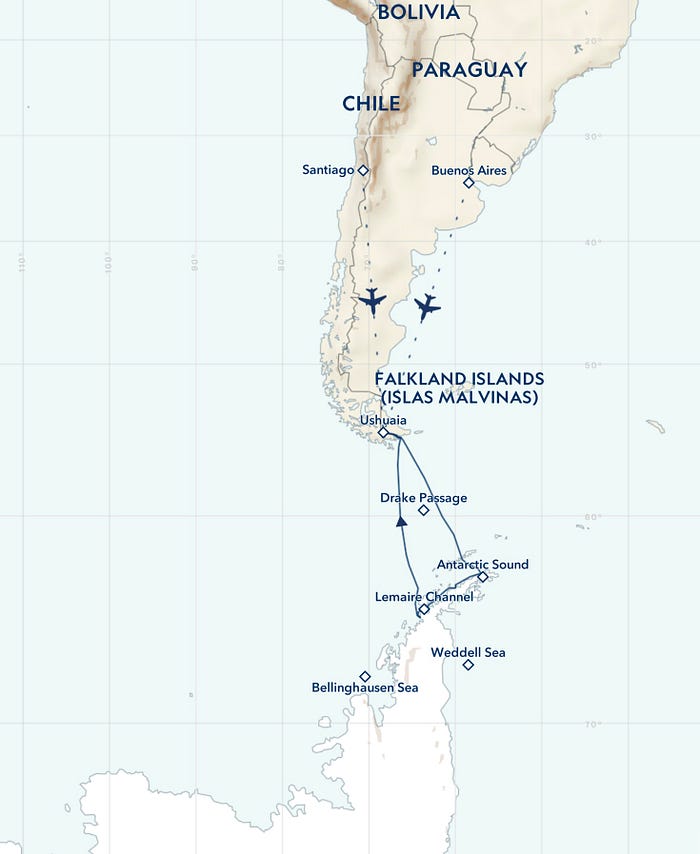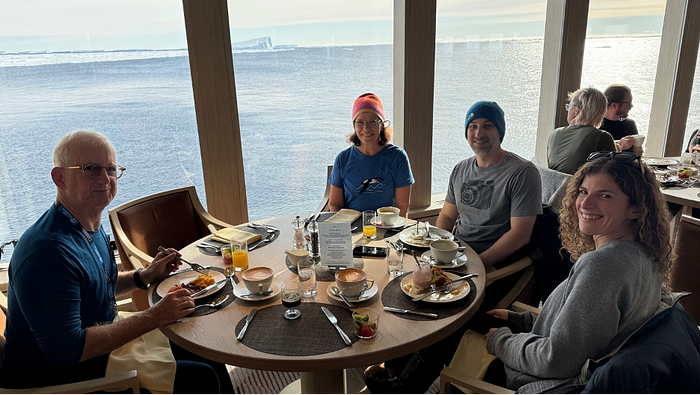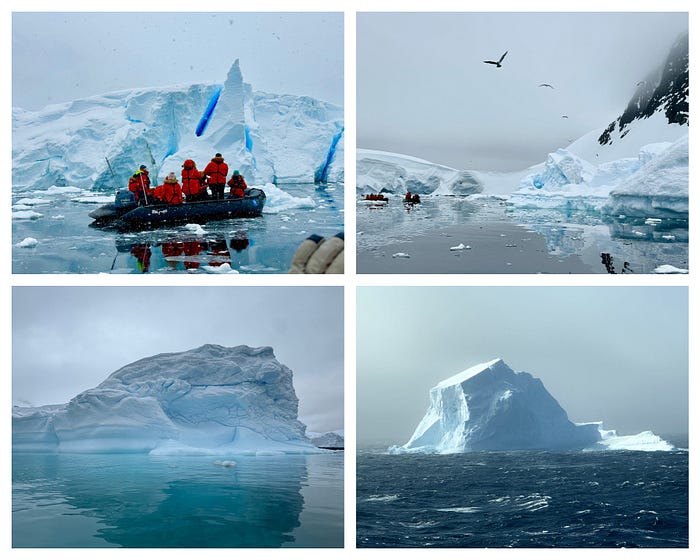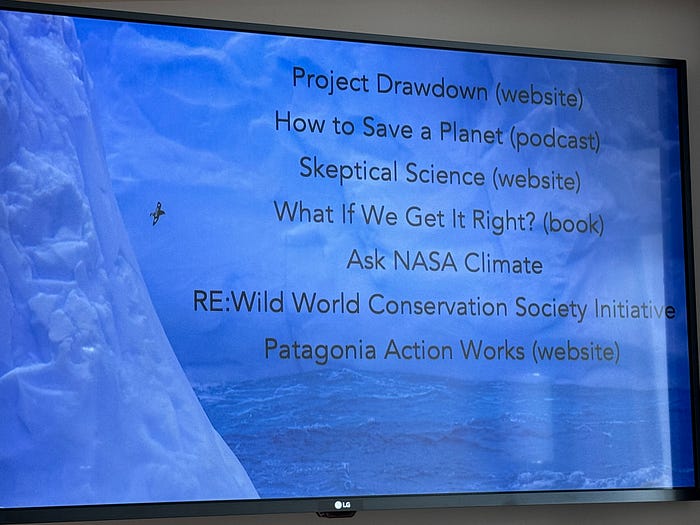A Wimp Tries an Antarctic Adventure
Ernest Shackleton Joined Us in Spirit
It’s easy to feel like a wimp when comparing our November, 2024 Antarctic journey to Ernest Shackleton’s 1914 Antarctic journey. His journey was written about in Endurance: Shackleton’s Incredible Voyage by Alfred Lansing, and Endurance: An Epic of Polar Adventure by Frank Arthur Worsley, and shown in these movies: Shackleton: The Greatest Story of Survival and The Endurance: Shackleton’s Legendary Antarctic Expedition.
Our family’s journey is written about here. Believe it or not, we did have some things in common with Shackleton.
A Ship Named Endurance
For example, we both traveled to Antarctica on a ship named the Endurance.

Our ship was also Endurance: the Lindblad Expedition National Geographic Endurance. The Lindblad Expedition company, a family-owned business since 1950, started collaborating with National Geographic in 2004.

Shackleton’s ship was officially laid to rest when ours was born. To explain: In 2022, Shackleton’s ship was found at the bottom of the Weddell Sea in the Antarctic. Also in 2022, our ship, the Lindblad Expedition National Geographic Endurance, had its first sail through the Weddell Sea.
Also, the two ships were designed by Norwegian shipbuilders. Shackleton’s ship was designed by Ole Aanderud Larsen and our ship was designed by the Ulstein Group. Norwegians know a bit about ice, since Norway is one of the ten coldest countries in the world. Disney mavens know that Norway was the inspiration for the movie Frozen.
We See Penguins!
The original Endurance and our ship have other things in common. We both returned home with 100% of the people who boarded. And although Shackleton was trying to reach the South Pole and we weren’t, we both watched hundreds of penguins shuffle, breed, and bicker, including emperors, gentoos, Adélies, and chinstraps. If you’ve ever watched penguins in a zoo, you know they are adorable. They waddle along in their formal tuxedo jackets and sometimes decide to slide on their bellies.



Herbert Hudson is naughtily holding young emperor penguins, who have a cute and different face from grown-up emperors. We were lucky to see a couple of them fully grown on November 26 on the Weddell Sea, when on sea ice.

Apparently emperor penguins rarely make it out of Antarctica onto the Antarctic peninsula, where we were. One of our guides said he waited two years to see one, so we were lucky.

I was surprised to see that penguins are not interested in people and not scared of people, despite the fact that they have been seeing people since Shackleton’s journey. Their behavior may stem from the fact that they have no natural predators on land, according to Jessie Johnson, one of the twelve naturalists on our ship. So they’d waddle right next to us. At that point Jessie would motion with her mitten that we needed to step aside, out of the penguin’s way.
After all, we were visitors in their home. We watched them waddle by. And we continued taking a photo or two. Or three…
Jessie said penguins are more careful when entering the water (where they fish for food) because they have predators in the water. (Some of them we saw on our trip, including the killer whale.)
Jessie also explained why the penguins didn’t seem that interested in sniffing us or checking us out. She said it was because we were in Antarctica in November — breeding season! So the penguins had love on their minds. Yes, we saw some penguins making baby penguins. And we saw them sitting on their eggs, waiting for them to hatch.

Watching the penguins was a feature of our trip.
A tiny bit different from Shackleton’s ad for his journey:

Our Itinerary
The original Endurance sailed from Buenos Aires to a whaling station on South Georgia Island just north of the Antarctic Peninsula. Interesting footnote — at that point Shackleton boarded the ship, because he had stayed behind for some last minute fundraising and caught up by steamer. Then the Endurance set sail for the Weddell Sea.
Our Lindblad National Geographic Endurance set sail from Ushuaia, on the southern tip of Argentina. By the time we boarded our Endurance ship, we had flown for 16 hours (Detroit to Atlanta — 3 hours, Atlanta to Buenos Aires — 10 hours, Buenos Aires to Ushuaia — 3 hours ), making this trip seem like a very long journey before it had technically even begun.
But let’s face it, I can only imagine those cold and wet Shackleton sailors looking with envy at our Delta flight with tiny bags of pretzels and chardonnay in a cup.
And we were lucky enough to visit with Merion cousins and speak Spanglish when we were in Buenos Aires.


Crossing the Drake Passage
Boarding the Endurance in Ushuaia, Argentina was exciting! It is a new and beautiful ship, built with a special “X” bow, built to cut through ice like butter.


Unlike Shackleton, we had just a few hours of darkness between about 12 and 3 AM. That’s because our 12-day sail from Ushuaia began on Nov. 24, close to the beginning of Antarctic summer. Our rooms had black-out curtains so we could sleep.
I didn’t know when we boarded the ship that long-lasting sun would also be quite an advantage. It meant we would be able to walk on sea ice one night at nearly 10 PM.

I was anxious, truth be told. Not about the amount of sun, but our 12-day journey from Ushuaia felt a little hazardous, at least compared to other trips we’ve taken in the other 6 continents. Friends who heard we were going to Antarctica seemed excited, until the worry emerged… “Oh, you are going to have to cross the Drake Passage!”
According to Wikipedia, “The Drake Passage is considered one of the most treacherous voyages for ships to make.”
As I write this, I am glad I didn’t read that Wikipedia entry BEFORE I went. We stocked up on seasickness meds. And I tried to block out the feeling that a smooth crossing on our way to Antarctica wouldn’t guarantee we’d make it smoothly across on the way back home. The sea decides when to get all uppity and jiggety.
But Phil, the ship’s “Bird Nerd,” who sported a handsome 6 inch long beard the same auburn color of Alison’s hair, consoled me by saying “The Drake always has great birds!”

Petrels and albatrosses enjoyed following our ship.


After we signed up for the trip in June of 2023, Lindblad started offering trips where you can fly over the Drake Passage each way, by flying to a Chilean Research Station on King George Island.
As the Lindblad ad promised (and Shackleton never mentioned in his ad), we did see amazing amounts of wildlife, including whales and seals, along with the penguins.
Here’s a list anyone could add to in the bridge. They had a new list like this every day.

“Safety is Our Priority”
Having gone to Antarctica the wimp way, I can still see why Lindblad promotes this trip by saying “Safety is the Priority.” In fact, we’d often watch the Nat Geo naturalist team on that day’s “scouting expedition.” We’d see them go off in a zodiac, checking out the safety of that morning’s or afternoon’s expedition location.
For example, they’d check to see if there was any sign of animals done in by bird flu on land (what? scary!) and if the sea ice was going to hold us. But still we were required to leave our black horseshoe-shaped life preservers on when we had to pull the ship, to help it out of the ice, just like Shackleton’s men.



On this day we were told to quickly exit the zodiac and climb up the hill, because this area was in danger of a tsunami from calving ice.
This is when a glacier naturally pushes off a wedge, like slowly pushing a loaf cake that is not on a plate over the edge of a table — a piece is about to fall off. In this case, it could hit the water and cause a tsunami on the hill we were climbing to watch penguins.
There were other dangers.
We had an amazing captain named Capt. Oliver Kruess, who has been sailing for over three decades. What he didn’t tell us was the story of how he had helped rescue over 100 passengers just like us in a modern day Titanic-like situation with a much better ending in 2009.
Despite the dangers, or maybe because of the adventure that goes along with the whiffs of danger, this wimp loved the trip.
Fun Stuff We Did
My anxiety was ameliorated by doing a ton of fun things (besides watching the penguins.)
We watched for whale bodies and tails like this:


We learned there is a website called happywhale.com where you can submit a photo of the tail, called the fluke of the whale, and get it identified — the tails are like fingerprints.





We visited the “open bridge” to watch the captain sail the ship.



We observed penguins doing things they could never do in a zoo. One day we watched a penguin walk over and steal a pebble from his friend’s nest for his own nest, in a ritual that likely repeats all day. My friend Ann said when told this anecdote, “What else do they have to do?”

We did the “polar plunge” in 28 degree water along with 60 other passengers in this 110 passenger ship. My daughter Alison in the black suit looks like she is a conquering hero and I look like I ate a lemon, because I was covering my nose. But I did it!

Questions people have asked us:
Q. Were you cold?
A. No, because the air temperature was 32 degrees Fahrenheit, at the beginning of the Antarctica summer. We were given packing lists. When we went out, I had two pairs of socks on (a light liner and a heavy wool sock), heavy waterproof boots because we needed to step into water to get in and out of the zodiacs, and I wore 3 layers on my legs (wool long underwear, heavy workout pants, and a waterproof rain pant.) On the top of my body I had 4 or 5 layers, including a long sleeve shirt, a fleece, and a parka. I also had on my hat and scarf and two gloves on each hand (a light liner that I could use my phone camera with and a heavier one on top to put on when my hands got cold). And if it was windy, our parka had a hood. In general, we were outside for about 2–3 hours at a time. When we hiked or cross-country skied, I often got too warm and sometimes took my coat off. I brought a vest with a battery that could heat it up but I didn’t really need it. Same for the warm up packs people use when skiing.
Q. Was the water cold when you jumped in?
A. Yes, but we were only in it for a few seconds. I was coldest when we walked on the platform to the raft through 3 inches of water in bare feet. After the jump, you get a dry towel, a shot of vanilla vodka, a hot chocolate, and a “I did the polar plunge” patch.
Q. Did you get sea sick?
A. No, but some people did. The captain said that we didn’t have rough seas both times we crossed the Drake Passage. We were lucky in that regard.
Q. Was the food good?
A. It was delicious and plentiful and beautiful. The pastry chef went wild and made seven types of pie for dessert on Thanksgiving.
Q. Did you see polar bears?
A. No. Polar bears only live in the North Pole. Penguins only live in the South Pole. They never hang out together, except on a bottle of Coke.
Q. Would you go back?
A. Yes, but there are a lot of other places to go to first. We did meet one couple who had been to Antarctica 5 times, and another who had been on 23 National Geographic expeditions.
How We Are Changed
The ship had talks and practices that fostered:
Less plastics. There are no plastic bottles on the ship. Everyone is issued a metal water bottle upon embarking, and there are refillable water stations on every floor. At one time, Jamie Coleman, the expedition leader, showed the contents of a fish’s stomach who had eaten plastics. That was striking.
Sustainable fishing. For example, the ship wouldn’t serve any shrimp because they couldn’t find a sustainable option. Maya Santangelo, one of the two divers on the ship, spoke about this.

An understanding of global warming. For example, naturalist Eric Guth and Lindblad Expeditions were carrying on the work of James Balog from the Earth Vision Institute, which created the film Chasing Ice. This film shows the effect of dozens of cameras that each took one photo a day of a glacier. The photos were used to create a time-lapse video that showed how those glaciers changed over time. At one point our ship dropped off Eric to grab a full memory card of images from a camera and replace the card with an empty one.
I hated plastic bottles before this cruise, and continue that feeling. I never leave the house without a filled metal water bottle. It’s a small thing. I also recently read A Year of No Garbage by Eve O. Schaub and I’ve been recommending it to others. I took notes on the ship and continue to consider and share the wealth of information provided, starting with this article.
I’m not sure we can turn global warming around. But as I ponder this, I wonder: What would Shackleton say? What will my granddaughters’ earth be like? Here are some suggestions for being more knowledgeable about the situation, from one of the final talks on the ship.

Photos without credits were by Debbie Merion, taken with an iPhone 15 Pro.
Thank you for reading. Thank you also to the crew of the Lindblad Nat Geo Endurance for keeping us warm, dry, safe, well fed, and so fulfilled with adventure, fun, and new information about this earth we live on.

Here is a cartoon I created from our journey, with a create-your-own New Yorker-type caption game.

Do you want to try to think of a funny caption? Go ahead, I’ll wait. I appreciate your effort. The photo I took seemed ripe for a funny line. I couldn’t think of one.
Tell me your idea in the comments? Or tell me any other thoughts or questions you have. I’d love to hear them!
Friends and family on Facebook did come up with 11 options for captions.
Curious? Don’t scroll yet if you’re still trying to think of your own. Go for it! 👍
Ok. Write yours down if you have one?
Here are some captions suggested:
“Rift-raft invasion. There goes the neighborhood.”
“Get Off Of My Cloud”
“Looking for a guide? I know these waterways well”
“You’re invading my territory.”
“Don’t leave!!”
“Trouble at the tundra.”
“Well those are some funny looking penguins…haven’t seen them around here before.”
“Hey, you guys! YOU’RE GOING THE WRONG WAY !”
“They’re back again this year?”
“@%$*!? illegal immigrants…”
“Hey you in the boat, Jupiter Beach is the other way”
I hope this story was interesting and helpful.
